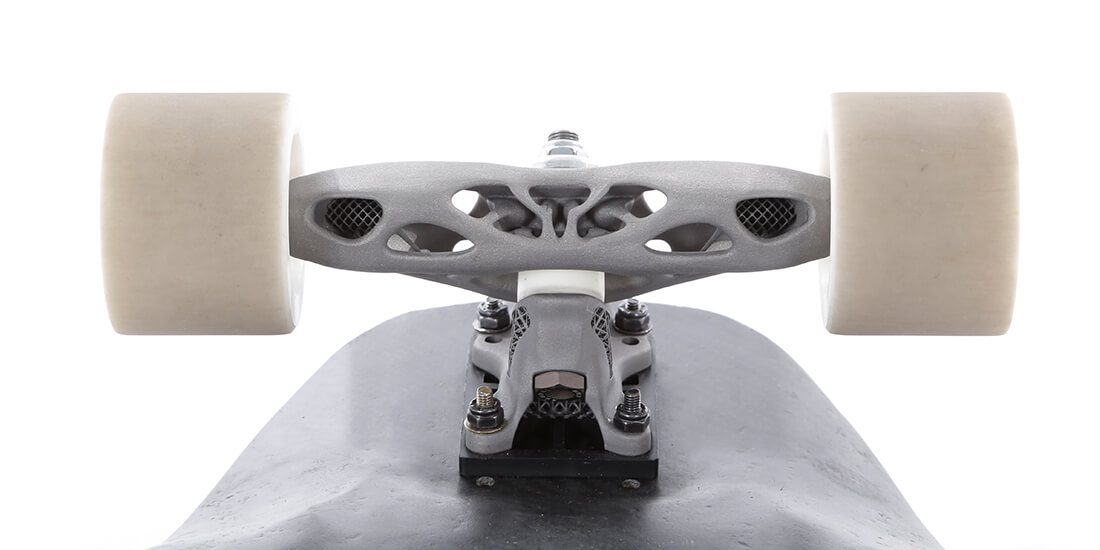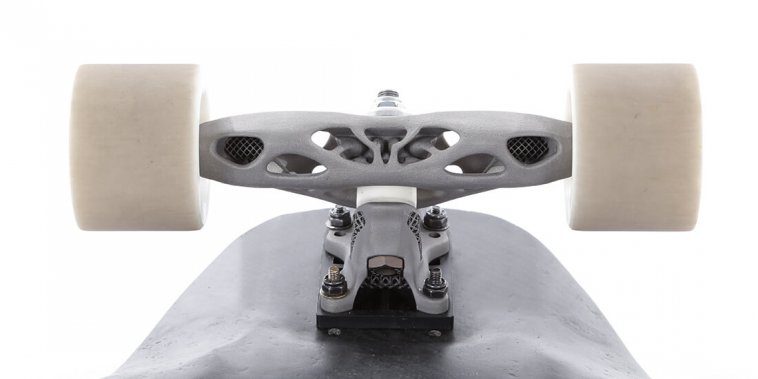Engineering student Philipp Manger designed a pair of custom skateboard trucks for downhill racing — combining topological optimization and lattice structures — and had them 3D printed in metal.
Downhill longboarding is an extreme sport combining skateboarding and surfing, capable of speeds of more than 90 miles per hour. Naturally, optimizing your gear for performance is important, not least of which are the skateboard trucks.
The truck of a skateboard sits on the underside of the deck. Made of axles, bushes, and pins, the truck is the interface between the wheels and deck. It provides the rider with the necessary control when they shift their weight, bending and reacting to the travel of the board.
Precision-engineering student and downhill skateboarder Philipp Manger combined both passions in developing new skateboard trucks. Project TOST (Topology Optimized Skateboard Trucks) is specifically concerned with downhill longboarding. Where traditional skateboard truck designs are best for thrashing in the streets; a style called the reverse-kingpin truck is better for longboarding and high-speed skateboarding.
“It’s the only skateboard part I haven’t made before, and it fit perfectly to try out these new technologies,” he says. Drawing on more than 15 years experience in engineering, learning CAD and 3D design to work on — among other things — steering columns for the Mini Cooper, the German native was ready to tackle skateboard redesign.
“It gave me a lot of preparation. No matter what you’re doing, engineering is engineering,” he enthuses.
“If you design a part for a car, it’s not a lot different than for a skateboard — they’re both design. And I had the opportunity to learn a lot about design methods, what’s called parametrical constructions or parametric modeling. I tried out a lot of different CAD tools, and it’s very hands-on.”
Project TOST are a New Breed of Skateboard Trucks
To optimize the reverse-kingpin truck, Manger set out to achieve the same stiffness while reducing the overall weight. He used Autodesk Fusion 360 and Netfabb to generate a lattice structure. Lattice designs are intricate constructions that offer significant improvements in weight, performance, and strength; this is a big deal to industries like aerospace, but is it really necessary for a skateboard?
“In terms of downhill skateboarding, if you try to brake from 80 kilometers per hour on a board weighing 5 kilograms, it’s harder than a board of 3 or 4 kilograms, so it makes the whole handling easier,” Manger explains. That, plus any reduction in weight will make the board easier to carry when trudging back uphill.
But topology-optimized designs like Manger’s skateboard trucks are impossible to manufacture traditionally. Milling or casting techniques are not able to provide the necessary detail or precision. Undeterred, he turned to Fraunhofer IWU, a German production-technology institute.
“The Institute’s focus is on metal additive manufacturing and other lightweight designs, so it was the perfect partner,” Manger says.
“I was happy to find such a big organization to work with, and they supported me with the access to the building and manufacturing facilities, especially a GE Concept Laser M2, which is a laser-beam-melting machine. It gave me a lot of know-how.”
Currently, Manger has no formal plans to commercialize his futuristic new skateboard trucks.
“The project wasn’t really about creating a skateboard truck. It was more about finding new ways for lightweight designs for metal additive manufacturing,” he says.
“Project TOST shows new approaches from the combination of organic forms and lattice structures. The skateboard trucks just happen to be a demonstrator that everyone can understand.”

Source: Autodesk
Website: LINK


